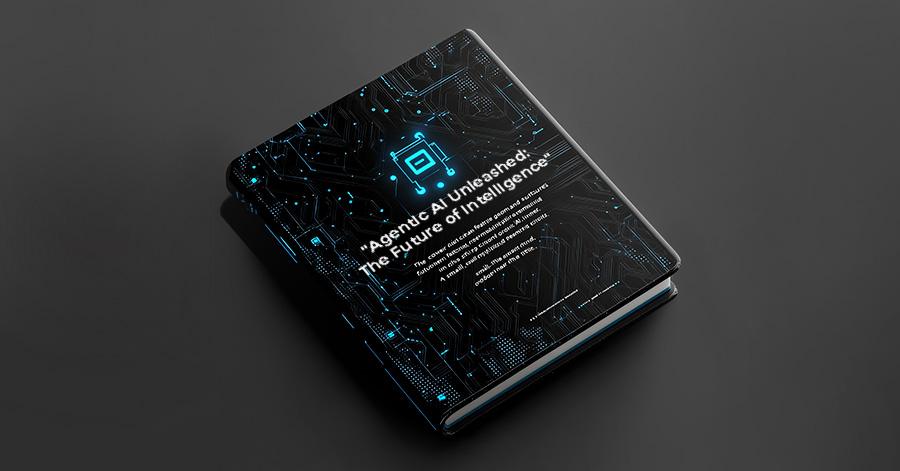The Ultimate Guide to Agentic AI - The Future of Autonomous Intelligence
- Mar 2025
- 151
- 0

Introduction: What is Agentic AI?
The Shift from Reactive to Autonomous AI Agentic AI refers to artificial intelligence systems that act independently, set goals, plan actions, and adapt dynamically to their environment -going beyond traditional AI models that merely respond to inputs.
These systems:
Take initiative instead of waiting for human prompts Learn from their own experiences and improve over time
-
Utilize external tools and services for enhanced functionality
-
Work autonomously while still being aligned with human objectives
Why It Matters Now
The rise of agentic AI marks a shift from narrow AI assistants (like chatbots or recommendation systems) to fully autonomous problem-solvers that can execute complex tasks in business, research, creativity, and everyday life.
How Agentic AI Works: The Core Components
1. Foundation Models (The Brain) Large Language Models (LLMs) like GPT-4, Claude, and PaLM provide reasoning, problem-solving, and language understanding, forming the intelligence behind agentic AI.
2. Planning Modules (The Strategy Maker) These help AI break down tasks into smaller steps, prioritize actions, and predict outcomes efficiently.
3. Memory Systems (The Experience Holder) Short-term memory: Helps AI retain context within a session Long-term memory: Allows AI to recall past interactions and improve performance over time
4. Tool Use Interfaces (The Hands) Agentic AI connects with APIs, web tools, and software (e.g., LangChain, AutoGPT) to perform actions beyond just text generation.
5. Feedback Mechanisms (The Learning Engine) These help AI refine its performance based on success and failure, ensuring continuous self-improvement.
Real-World Applications: Where is Agentic AI Used Today?
1. Business Automation Devin (Cognition Labs):
The first AI software engineer, capable of writing, debugging, and managing codebases autonomously. Microsoft Copilot: Automates emails, document summaries, data analysis, and task planning.
2. Customer Service Claude (Anthropic):
Handles detailed customer queries, learns company policies, and provides human-like support.
3. AI-Powered Personal Assistants ChatGPT + Plugins:
Browses the web, executes calculations, retrieves information, and even interacts with booking services. Claude Code: Acts as a command-line assistant for developers.
4. Scientific Research & Drug Discovery BioNeMo (NVIDIA):
Helps design new medicines and predict chemical interactions. ChemCrow: Plans complex chemical syntheses and evaluates reaction pathways.
5. Creative Content & Media RunwayML Gen-2:
Generates AI-driven videos and multimedia content. Adobe Firefly:Uses AI to assist in design, inpainting, and creative asset generation.
Challenges in Agentic AI Development
1. Reasoning & Planning Issues Limited long-term planning:
AI struggles with complex multi-step reasoning. Hallucinations: AI sometimes generates incorrect or misleading information.
2. Memory & Learning Limitations Forgetting past interactions:
Most AI models have a limited context window, making long-term adaptation difficult. Lack of knowledge updates: AI struggles to incorporate new facts without explicit retraining.
3. Reliability & Safety Concerns Unpredictable behavior:
AI might misinterpret tasks and act in unintended ways. Security risks: Autonomous AI needs strict controls to prevent misuse or data breaches.
Ethical & Social Impact of Agentic AI
1. The Future of Work Automation vs. Human Jobs:
Routine jobs may decline, but new roles in AI management and oversight will emerge. Skill Shifts: Human workers will need to focus on creativity, strategy, and ethical judgment.
2. Transparency & Accountability Explainability Issues:
AI decisions can be difficult to trace and audit. Who is Responsible?: AI errors raise legal and ethical questions about accountability.
3. Ensuring AI Stays Aligned with Human Values Regulatory Frameworks:
Governments are exploring policies to control AI autonomy. Override Mechanisms: AI systems must be designed to defer to human judgment in critical situations.
The Future of Agentic AI: What’s Next?
-
Enhanced Reasoning Capabilities AI will improve at causal reasoning, self-reflection, and logical planning over long durations.
-
Multimodal AI Integration AI will combine text, audio, images, and real-world interaction for more immersive and intelligent decision-making.
-
Smarter Learning & Adaptation AI will become better at remembering and improving over time without losing previous knowledge.
-
Expansion into New Industries Healthcare: AI-powered diagnosis and treatment planning.
Education: AI tutors personalized to students' learning styles.
Climate Tech: AI-driven environmental monitoring and sustainability solutions.
Final Thoughts: Why Agentic AI is a Game-Changer Agentic AI is reshaping industries by enabling machines to think, act, and improve on their own. From automating tedious business tasks to assisting in research, creative work, and personal assistance, these systems are evolving rapidly.
While challenges remain—ethical risks, reliability concerns, and security threats—the future of AI is undeniably agentic. Businesses, researchers, and policymakers must work together to harness its potential responsibly.
Will AI Become Fully Autonomous? For now, agentic AI still requires human oversight, but as its reasoning capabilities improve, it will likely take on even more responsibilities—augmenting human intelligence rather than replacing it.



Comments
No comments yet.
Add Your Comment
Thank you, for commenting !!
Your comment is under moderation...
Keep reading blog post